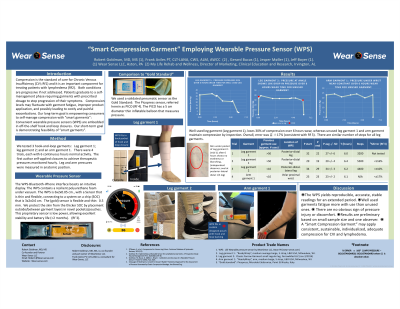Practice Innovations
(PI-019) Feasibility of a Wearable Pressure Sensor for Lymphedema Garments

Lymphedema is a disfiguring condition of indurated fibrotic edema treated by complete decompressive therapy (CDT). After CDT people get maintenance compression garments (Reference 1). Consumers apply maintenance garments “by feel” without sense of when garments fatigue. Too much/little compression leads to costly, painful exacerbations. Our long-term goal is empowering consumers to self-manage compression with a convenient wearable pressure sensor (WPS). Our short-term goal is demonstrating feasibility.
Methods:
The WPS sensor is 6x2x0.05 cm., which is thin and flexible, connecting to an electronics control module (ECM) that is 3x2x0.6 cm. We protect the skin from the thicker ECM by placement outside/between garment layers in novel pockets/pouches. The WPS-Bluetooth-iPhone interface boasts an intuitive display. We tested 3 hook-and-loop garments: 1) Leg wrap 1 (LW1); Leg wrap 2 (LW2), and an arm/forearm wrap (AFR1). There were 4 trials, each with 6 continuous hours normal activity. The author self-applied closures to achieve therapeutic pressures monitored hourly. Leg and arm pressures were measured in anatomic position.
Results:
The table shows pressure, activity, and WPS location: P=pressure; SD=standard deviation; T=time;
Error=100%*(⏐WPS pressure- “gold-standard” pressure⏐/”gold-standard” pressure).
Trial | Hook& Loop closure | Previous garment use (est) | Location of WPS | P start | P end | P avg +/- SD | T (hours) | Steps | Error |
1 | LW1 | >50 times | Posterior-distal leg | 32 | 22 | 27+/-6 | 6.0 | 3200 | NA |
2 | LW1 | >50 times | Posterior-distal leg | 29 | 19 | 20+/-4 | 6.4 | 5500 | < 16% |
3 | LW2 | < 10 times | Post-distal lateral leg | 34 | 29 | 34+/-3 | 6.2 | 4400 | < 10% |
4 | AFW1 | < 10 times | Volar prox. wrist | 23 | 23 | 23+/-2 | 6.1 | N/A | < 17% |
We observe that well-used garments lose more pressure with time than unused ones. This study is consistent with previously reported error of +/-15% (Reference 2). The author self-inspected skin post-wear and found no discomfort or obvious erythema from the WPS/garment during any trial.
Discussion:
Preliminarily: 1) The WPS yields reproducible, accurate, stable readings for an extended period; 2) well used wraps fatigue more with use than unused ones; 3) there are no obvious sign of pressure injury or discomfort for any wrap. Results are preliminary based on small sample size and one observer. The wearable sensor may hold promise as a wearable sensor for lymphedema garments.

.jpg)